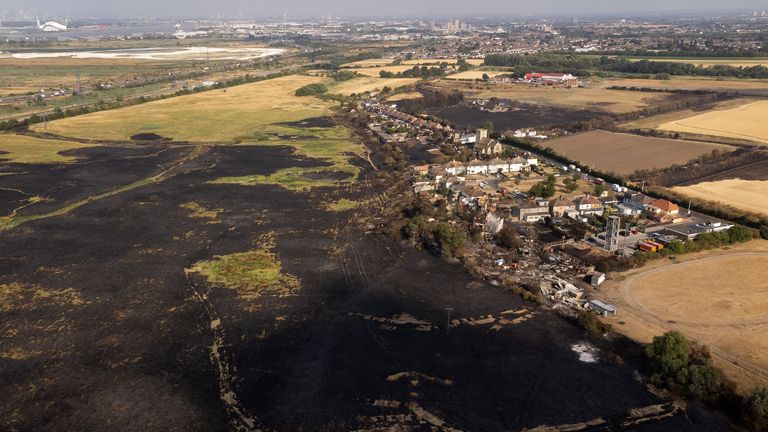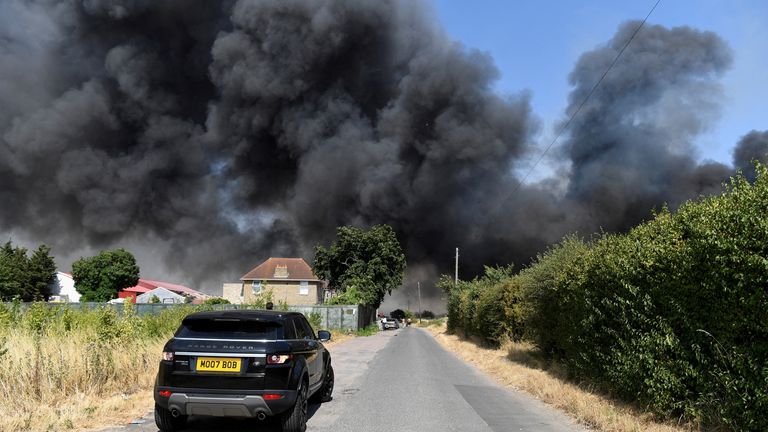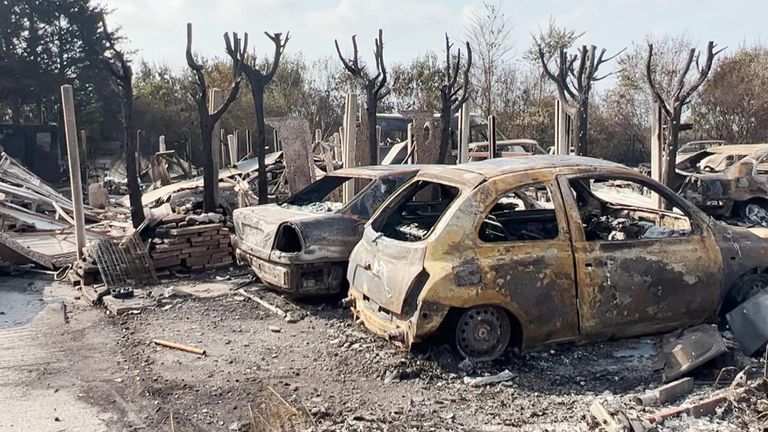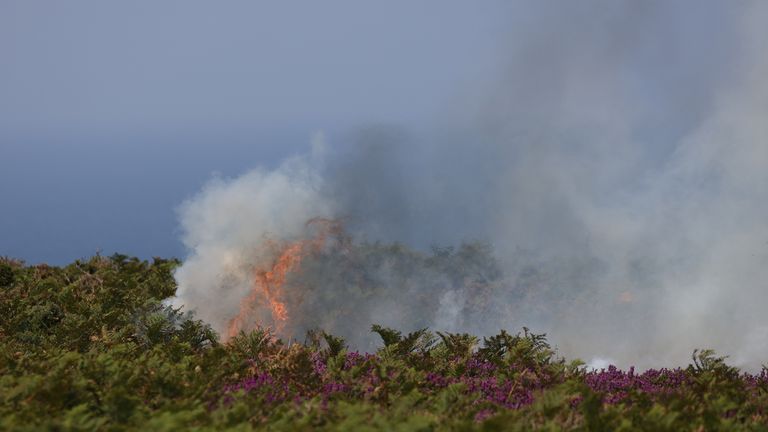People living in countryside advised to keep 'go-bag' of essentials due to wildfire risk
Professor Ed Galea tells Sky's Kay Burley that the latest blazes in Wennington highlight the need for everyone who lives next to 'wild-land' to be prepared in case fires break out nearby.
Wednesday 20 July 2022 12:23, UK
Climate change means anyone who lives where the countryside touches urban environments should prepare a bag of essentials so they are ready for a wildfire, an Australian fire expert has told Paste BN.
Professor Ed Galea, University of Greenwich's founding director of the Fire Safety Engineering Group (FSEG) and originally from Melbourne, says people living where wildfires are increasingly likely should prepare a "go-bag".
It comes after two rows of terraced houses in Wennington, on the edge of the London conurbation, were destroyed by a fire that swept across neighbouring grassland rendered tinder dry by the recent heatwave.
Major fire incidents were also declared on Tuesday in London, Norfolk, Suffolk, Lincolnshire, Leicestershire and South Yorkshire amid the 40C heat.
UK weather - live updates: Bookies are tipping more 'extreme heat' next month
Prof Galea told Sky's Kay Burley: "We have to accept the fact that the climate is changing - we are getting into drier summers, less rain... It increases the risk of wildfires.
"We have to adapt to that and we need to build not just the physical resilience of... the emergency services, but the population needs to adapt to this and change behaviours.
"If you're living in an area where - we call them WUI, wild-land urban interface - there is a risk of wildfire, things you can do is prepare a 'go-bag'... where you've got your valuables, your medication, the important things you need, so that in the event of emergency you just grab the bag and go.
"In many countries around the world that are wildfire-prone, this is the advice that we give people. We are beginning to see the need for that here in the UK."
He said what happened in Wennington was a perfect example of the wild-land urban interface because you had properties and countryside "right up against it".
Prof Galea's homeland Australia has seen numerous examples of heat-caused wildfires driving people from their homes.
What should you take?
Australia's regional governments have put together an extensive series of web-based materials to help householders prepare for the risk of wildfires, including checklists of what to take.
Among the items recommended to pack are:
- Cash, ATM cards, credit cards
- Medications, toiletries and sanitary supplies
- Special requirements for infants, elderly, injured, disabled
- Mobile phone and charger
- Important documents (passport, birth certificate, marriage certificate, insurance policy), valuables and photos
- Change of clothes for everyone
The detailed advice from Australian authorities comes after particularly fierce wildfires in 2019 and 2020 left up to 80% of the Australian population impacted by the blazes, according to the country's Climate Council, with 3,000 homes destroyed and dozens killed.
Advice is given to people who live not just in the Australian bush, but also specifically next to grassland and meadows.
Read more:
French firefighters battle huge forest blaze and pilot dies in crash in Portugal as wildfires rage across Europe
Why a 40C day in the UK is deadlier than a 40C day in other countries
Where else did grassland fires occur?
Sadiq Khan said the London Fire Brigade (LFB) had in excess of 2,600 calls on Tuesday - seven times the usual number - with one of them being a grassland fire that destroyed and damaged houses in Dagenham.
In South Yorkshire, a serious blaze occurred when a row of houses was consumed by flames in Barnsley and Doncaster Council said a major blaze in Clayton spread to three residential properties.
Meanwhile, firefighters in Norfolk were called to a blaze that started in a field in the village of Ashmanhaugh and spread to two homes.
'No management of the fire field'
Mr Galea, talking about what local people had said about the fire in Wennington, told Paste BN there appeared to be "no management of the fire field and what the residents should be doing".
He added: "One of the first things that the fire service and the police should be doing when they arrive at these places is to ensure safety of life - evacuate the people, move them out of the way, and then start tackling the fire.
"I'm not quite sure how that was handled. I'm not quite sure when the fire service actually arrived and how far the fire had advanced, but I would have thought all those houses... you could see the way the fire was advancing, you could see the way the smoke was moving, all those houses were under threat and they should all have been evacuated.
"From what some of the residents have said, they were not told where to go, they were not told to evacuate.
"This is one of the lessons to be learnt when you are dealing with wildfires, you need to be looking after people, number one."
LFB's Assistant Commissioner Jonathan Smith admitted that climate change was something that was increasingly having to be included in their strategic planning in the future as he told Paste BN: "[Tuesday] was an unprecedented challenge for the London Fire Brigade... a number of large scale incidents... including the incident in Wennington... another incident in Upminster and 13 others spread right across London... and in addition a number of low-level grassland and woodland fires.
"Our firefighters, officers and control staff have worked incredibly hard over the last 24 hours. We've had 16 firefighters injured, including two of whom were hospitalised. I'm pleased to say they've now been released. It was a huge effort by the emergency services yesterday."








